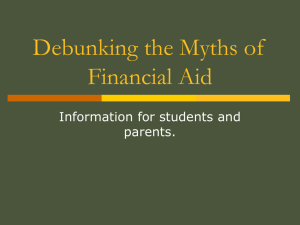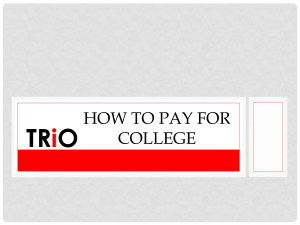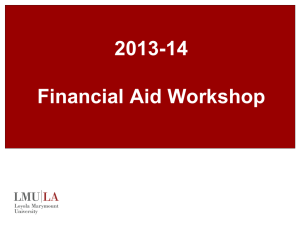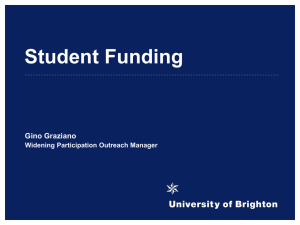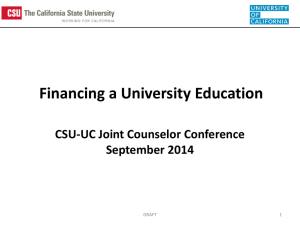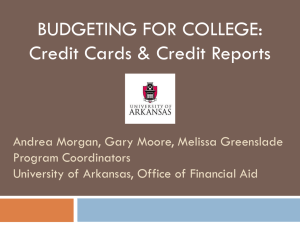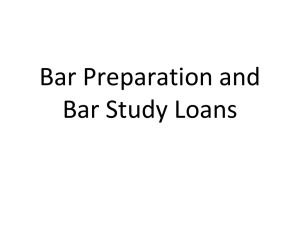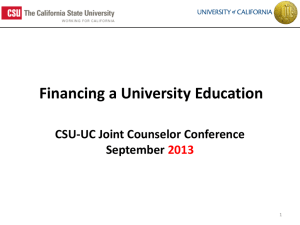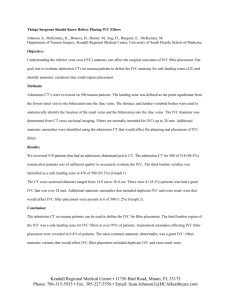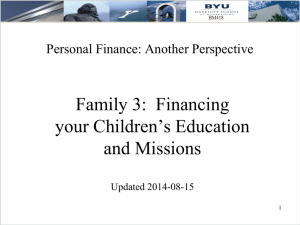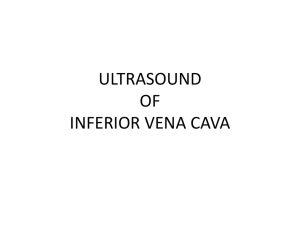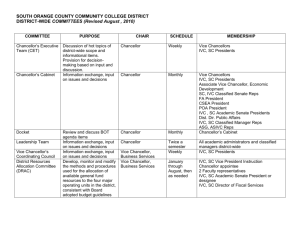How to Pay for College
advertisement
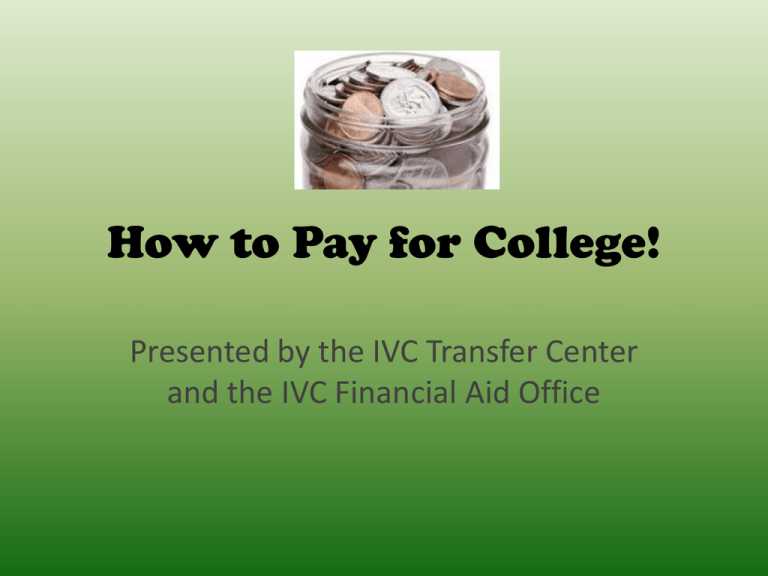
How to Pay for College! Presented by the IVC Transfer Center and the IVC Financial Aid Office It’s not just college that is expensive… Financing your education is like buying a car. After you do all of that research and settle on your wheels, it’s not just the sticker price you have to pay. There is insurance, gas, maintenance, repairs, etc. What to budget for… • • • • • • • Tuition Books and materials Transportation Personal Health Insurance Room and Board Food What do you think each one of these will cost at UC, for example? 9 month budget for UC student • Tuition - $13,200* • Books and Supplies - $1500 • Personal Transportation - $ 2200-3000 • Health Insurance - $1900 • Room and Board – $9300 – 14,000 Total: $29,200-33,100 *add $23,000 for non-resident tuition Source: http://admission.universityofcalifornia.edu/paying-for-uc/tuition-and-cost/index.html Some budgeting resources… • http://www.direct.ed.gov/BudgetCalc/budget.html - helps you determine your expenses and estimate your total available income including financial aid and employment • https://secure.californiacolleges.edu/Financial_Aid_Planning/_default.aspx - a cash cow of financial aid information including links to all UC and CSU financial aid websites, sample expense charts, sample finance plans, and much more! • www.mint.com – a free online tool to help you organize your expenses and accounts • http://www.finaid.org/calculators/finaidestimate.phtml - a free financial aid calculator to estimate your potential student aid award • http://www.calstate.edu/sas/costofattendance/ - CSU cost of attendance for each campus • http://studentnpc.collegeboard.org/participating-schools - Net Price Calculators for participating schools allow you to estimate your net price to attend Who is expected to pay for all of this? • Good question. Depending on your family income if you’re dependent or your (and spouse’s) income if you are independent, there will be an amount the university will expect your family or you to contribute. This is the EFC (Expected Family Contribution) or SC (Student Contribution) • Students will be expected to work and borrow • Parents of dependent students are expected to help based on their financial strength • Dependent students and parents together pay the “net cost” or “net price” • The rest comes from student aid (also called “gift aid”) Types of student aid available… • • • • • Grants – such as Cal Grant, Pell Grant, FSEOG, EOP, SUG Fee Waivers – available for CCC students Scholarships – merit or need-based Work Study – part-time work on or off-campus Institutional Aid – can be in the form of scholarships, grants, or loans available at a particular institution • Loans – Federal Direct Loans or PLUS Parent Loans, or private loans; emergency loans are also sometimes available Most students will have some combination of two or more of these – don’t put all of your eggs in one basket! How to apply for student aid… • Fee Waivers – available for CCC students. For IVC, go to http://www.ivc.edu/student/finaid/pages/programs.aspx. You will need your student ID and SSN • #1 resource is FAFSA - Free Application for Federal Student Aid – www.fafsa.ed.gov – February is the best time to apply using actual income info – Federal and State grants, loans, and work study – May also be used by institutional and private grant, scholarship, and loan programs – Pay special attention to due dates – March 2nd is the annual deadline for CA state aid, Cal Grant GPA verification and the priority date for other programs. – See handout How to apply for student aid… • California Dream Act application and resources http://www.csac.ca.gov/dream_act.asp – For students who meet AB 540 criteria and cannot use the FAFSA – Allows eligible students to apply for CA state financial aid (UC Grants, State University Grants, CCC Fee Waivers, and Cal Grants – Due date is March 2nd! Grants • 77% of CSU undergrads receive an average grant award of $7735 • 69% of UC undergrads receive an average grant award of $14,763 (UC costs twice that of CSU) • Depends on family income • Check the university website of the institution you want to attend to see a list of grants they award Scholarships • A scholarship application may include the following: – – – – – Application Essay Letter of Recommendation Transcripts Evaluation Form • Helpful hints: – – – – – – – Before you start, check the requirements to be sure you qualify Be sure application is complete before submitting Grammar and spelling should be checked for accuracy Answer questions completely Submit all materials together by deadline Follow up to be sure application was received and is complete Ask those who will write evaluation forms and letters of recommendation well in advance of the deadline and give them specific information they can use to write you a good letter – here is a checklist of what to provide your professor with – Request your official transcripts well in advance too. It usually takes 7-10 business days for the admissions office to process your request. Loans • Out of all of the types of student aid, this is the one you have to pay back • Federal Student and Parent Loans are the best fit for most undergrads at 6.8% interest • 59% of CSU undergrads borrow an average of $7485 per year with a cumulative loan debt at graduation of $15,804 • 43% of UC undergrads borrow an average annual loan of $6386 with a loan debt of $16,800 at graduation • The typical repayment over a 10 year period is $182 per month for CSU grads and $194 per month for UC grads • It is recommended that you don’t borrow more than you can pay off in 10 years with 10-15% of the entry-level salary in your field • Check out public service loan forgiveness • Avoid private loans and credit cards! Student Loan Debt Crisis • Beware! Total U.S. student loan debt has quadrupled since 2005, surpassing what Americans owe on cars and credit cards. In 2013, the Consumer Protection Financial Bureau announced student debt had topped $1.2 trillion. Seven out of ten college graduates left school owing an average of $29,400 each in student loans! After you apply… • For fall admission to a university, you usually are notified by 5/1 that you have or haven’t been admitted. This gives you about a month before you have to file your SIR (Statement of Intent to Register). After you are admitted, the university should send you a provisional award letter. • Once you receive your award letter based on FAFSA data, subtract your gift aid (grants & work study) from your budget and that is your net cost. Plan to cover that with loans, scholarships, and work. Since UC costs more, they supply more in student aid. You may find that a UC will cost you the same as a CSU. • You can use this information to determine amongst multiple choices, which university you will accept admission to. Ways to bring down your costs… • • • • • • • • Take a full-time load and finish your courses successfully Take summer courses Live with roommates or at home Ride your bike, walk, take the bus Work part-time Buy used books or rent when possible Use your student status to get discounts Live like a student when you are a student so you don’t have to once you graduate– forget the massages, fancy meals, vacations, and impulse purchases and bargain shop, reuse, recycle. Spend where it matters to meet your goals and save where it doesn’t. • Put away that credit card! Good luck! Contacts: IVC Financial Aid Office: 949.451.5287 IVC Transfer Center: 949.451.5339 IVC Counseling Center: 949.451.5251 IVC EOPS Office: 949.451.5243



